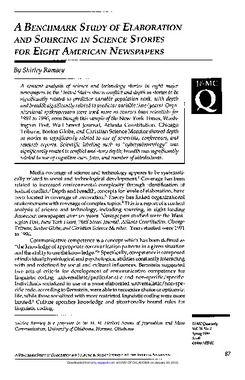| dc.contributor.author | Shirley Ramsey | |
| dc.date.accessioned | 2016-01-14T19:53:35Z | |
| dc.date.accessioned | 2016-03-30T15:30:52Z | |
| dc.date.available | 2016-01-14T19:53:35Z | |
| dc.date.available | 2016-03-30T15:30:52Z | |
| dc.date.issued | 1999-03-01 | |
| dc.identifier.citation | Ramsey, S. (1999). A Benchmark Study of Elaboration and Sourcing in Science Stories for Eight American Newspapers. Journalism & Mass Communication Quarterly, 76(1), 87-98. doi: 10.1177/107769909907600107 | en_US |
| dc.identifier.uri | https://hdl.handle.net/11244/25335 | |
| dc.description.abstract | A content analysis of science and technology stories in eight major newspapers in the United States shows conflict and depth in stories to be significantly related to predictor variable population rank, with depth and breadth significantly related to predictor variable time (years). Organizational spokespersons were used more as sources than scientists for 1991 to 1996, even though this sample of the New York Times, Washington Post, Wall Street Journal, Atlanta Constitution, Chicago Tribune, Boston Globe, and Christian Science Monitor showed depth in stories as significantly related to use of scientists, conferences, and research reports. Scientific labeling such as “cyberpaleontology” was significantly related to conflict and story depth; breadth was significantly related to use of cognitive cues, folio, and number of attributions. | en_US |
| dc.language.iso | en_US | en_US |
| dc.publisher | Journalism & Mass Communication Quarterly | |
| dc.title | A Benchmark Study of Elaboration and Sourcing in Science Stories for Eight American Newspapers | en_US |
| dc.type | Research Article | en_US |
| dc.description.peerreview | Yes | en_US |
| dc.description.peerreviewnotes | https://us.sagepub.com/en-us/nam/manuscript-submission-guidelines | en_US |
| dc.identifier.doi | 10.1177/107769909907600107 | en_US |
| dc.rights.requestable | false | en_US |
